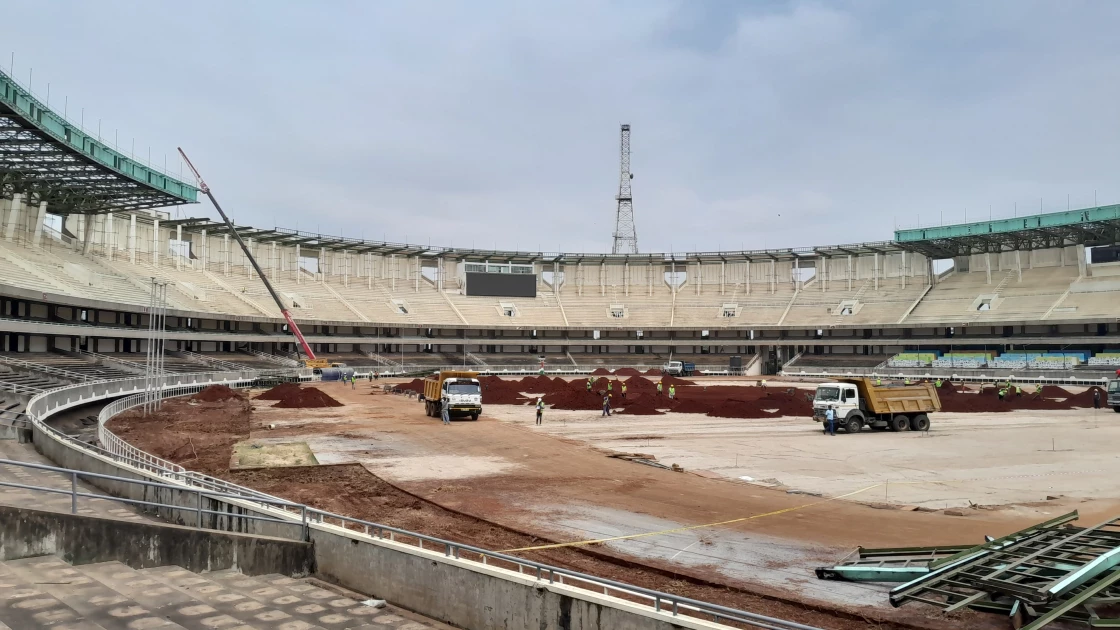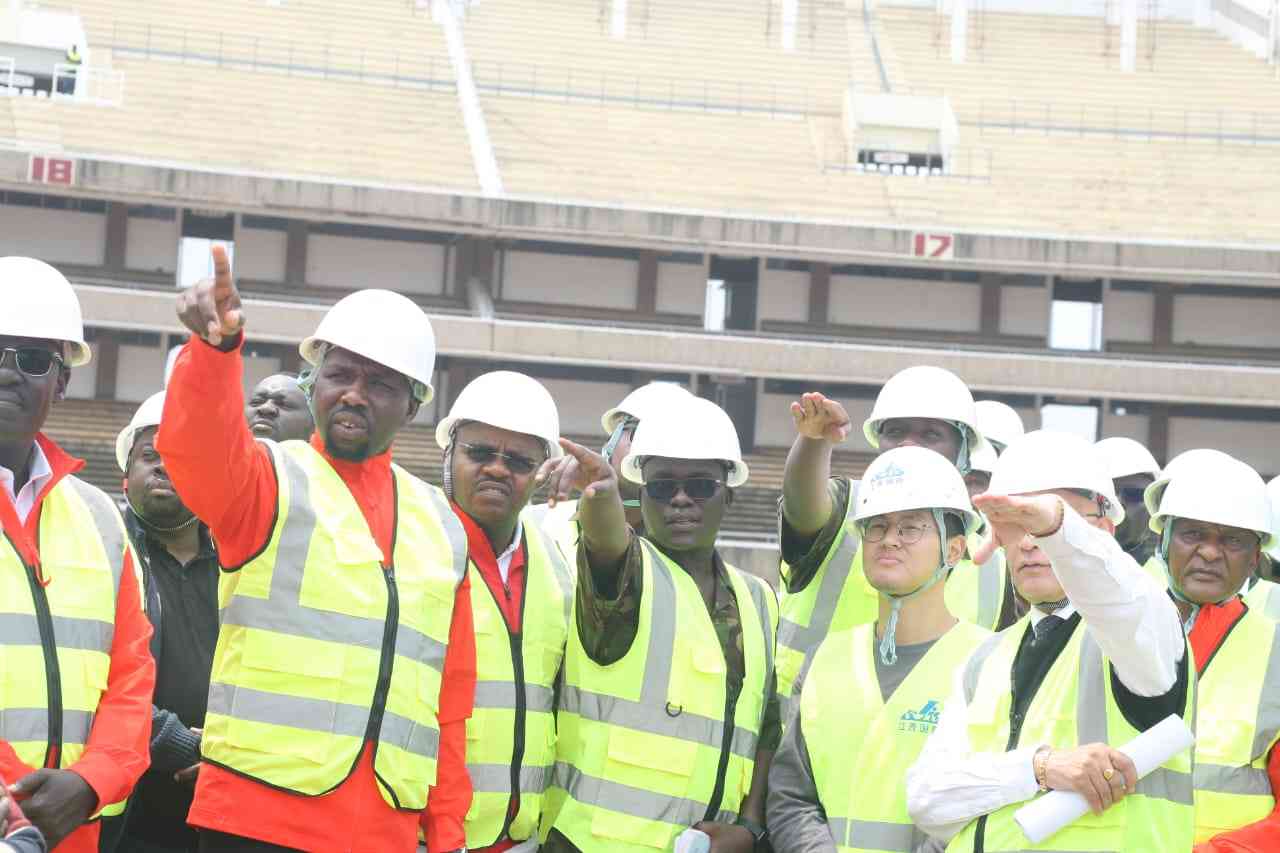Kipchumba Murkomen, the Sports Cabinet Secretary, has recently voiced his approval of the ongoing renovation and construction of sports facilities across Kenya. Following an inspection tour of Nyayo National Stadium, Moi International Sports Centre, Kasarani, and the Talanta Sports City Centre, Murkomen emphasized the critical need for certified construction standards. These standards will ensure that all stadiums built or renovated in Kenya meet international criteria, contributing to the long-term sustainability and utility of these essential infrastructures.
Progress in Stadia Renovations and Construction
During his inspection, Murkomen was particularly impressed with the progress made at the three key sports facilities. At Nyayo National Stadium, one of Kenya’s most iconic sports venues, significant renovations are underway to restore and upgrade the facility to meet international standards. The renovations include improvements to the seating arrangements, the playing surface, and other amenities aimed at enhancing the overall spectator experience.
At Moi International Sports Centre, Kasarani, similar efforts are being made to upgrade the stadium’s facilities. Kasarani has long been a cornerstone of Kenyan sports, hosting numerous national and international events. The current renovations are expected to bolster its reputation as a world-class venue capable of hosting large-scale events, including the Africa Cup of Nations (AFCON) in 2027, which Kenya is set to co-host with Uganda and Tanzania.

The Talanta Sports City Centre, a new development along Ngong Road, is perhaps the most ambitious of the projects Murkomen reviewed. This state-of-the-art facility is being constructed from scratch and is designed to be Kenya’s premier football venue. With a planned seating capacity of 60,000, the Talanta Sports City Centre is set to become the main venue for AFCON 2027, a significant milestone for Kenyan sports.
The Need for Certified Construction Standards
While Murkomen expressed satisfaction with the progress of these projects, he also highlighted a critical issue that has plagued sports infrastructure in Kenya: the lack of standardized construction practices. Over the years, numerous county stadiums have been built, only to deteriorate rapidly, often within five years of completion. This has led to a waste of public resources and has hampered the development of sports in various regions.
To address this issue, Murkomen announced his intention to gazette certified standards for the construction and maintenance of all stadiums in Kenya. These standards will apply to both new constructions and renovations, whether undertaken by private entities or the government. The goal is to ensure that all stadiums are built to last, providing long-term value to the communities they serve.
Murkomen’s proposed standards will cover various aspects of stadium construction, including the quality of materials used, the design and layout of the facilities, and the maintenance protocols that must be followed to keep the stadiums in top condition. By implementing these standards, the government aims to avoid the pitfalls of past projects and ensure that Kenya’s sports infrastructure is robust, durable, and capable of hosting international events.
Collaboration with County Governments
A key component of Murkomen’s strategy is collaboration with county governments. Many of the stadiums that have faced durability issues were built or renovated by county governments, often with limited oversight or adherence to national standards. To rectify this, Murkomen plans to work closely with county governments to ensure that all stadium projects adhere to the new certified standards.
This collaboration will involve providing technical support to counties, helping them to understand and implement the required standards. Additionally, the national government will play a more active role in monitoring the progress of county-level stadium projects, ensuring that they meet the specified criteria before being certified as complete.
Murkomen also emphasized the importance of using modern technology in stadium construction. By incorporating the latest building techniques and materials, Kenya can ensure that its stadiums are not only durable but also environmentally sustainable and energy-efficient. This approach will position Kenya as a leader in sports infrastructure development in Africa.
The Importance of Talanta Sports City Centre
Among the projects Murkomen inspected, the Talanta Sports City Centre stands out as a symbol of Kenya’s ambitions in the realm of sports. This 60,000-seater stadium is being constructed with the specific goal of serving as the main venue for AFCON 2027. The scale and significance of this project cannot be overstated, as it represents Kenya’s commitment to hosting world-class sporting events.
Murkomen expressed his admiration for the quality of work being done at Talanta Sports City, particularly by the Kenya Defence Forces and the Ministry of Sports officers who are overseeing the project. The stadium is designed to meet all international standards, ensuring that it will be a fitting venue for one of Africa’s most prestigious football tournaments.
The Talanta Sports City Centre is more than just a stadium; it is part of a larger sports complex that will include training facilities, accommodation for athletes, and other amenities. This holistic approach to sports infrastructure development is intended to create a center of excellence that will benefit Kenyan sports for generations to come.
A Vision for the Future of Kenyan Sports
Murkomen’s initiatives reflect a broader vision for the future of Kenyan sports. By establishing certified construction standards and ensuring that all stadiums are built to last, the government is laying the foundation for a more vibrant and sustainable sports culture in the country. This vision extends beyond football to include all sports, with the aim of creating a network of world-class facilities that can host international competitions and foster the development of local talent.
The focus on sustainability is also a key aspect of Murkomen’s plan. By building stadiums that are environmentally friendly and energy-efficient, Kenya can set an example for other countries in the region, demonstrating that it is possible to develop sports infrastructure that is both high-quality and sustainable.
Conclusion
As Kenya prepares to host AFCON 2027, the renovations and new constructions of sports facilities across the country are a testament to the government’s commitment to sports development. Sports CS Kipchumba Murkomen’s push for certified construction standards is a crucial step in ensuring that these facilities are built to last, providing long-term value to the nation.
ALSO READ:Excitement as 2024-2025 FKFPL Season Kicks Off: Match Previews and Predictions from JamboBet


